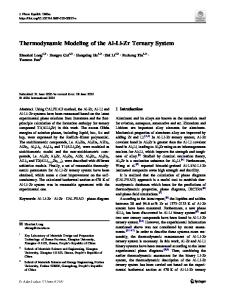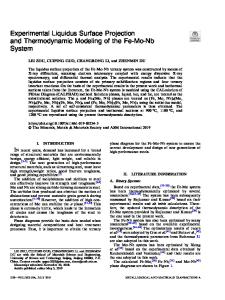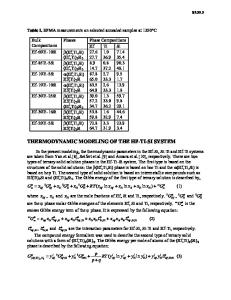Thermodynamic modeling of the indium-palladium system
- PDF / 204,172 Bytes
- 7 Pages / 612 x 792 pts (letter) Page_size
- 85 Downloads / 519 Views
RODUCTION
INTERMETALLIC compounds have recently attracted much attention due to their potential to be the next generation of structural materials for high-temperature applications. One class of these materials being actively investigated, which is formed between elements of Group VIII and elements of Group IIIA, e.g., NiAl, CoAl, and FeAl, has a strongly ordered bcc (commonly referred to as a CsCl, or B2-type) structure. It is well known that the mechanical properties of B2 compounds are largely dependent on concentrations of defects, i.e., constitutional vacancies and antisite defects,[1] and are significantly affected by diffusion at elevated temperatures. To model the complex diffusional process in a highly ordered B2 structure, both thermodynamic and kinetic data are essential. The In-Pd system has been chosen for this purpose, since the tracer diffusivity of both In and Pd in the InPd(B2) compound have already been experimentally determined by Hahn et al.[2] Since no thermodynamic assessment of the In-Pd system has yet been reported in the literature, the present work is, thus, aimed at developing a selfconsistent thermodynamic description for this system. Moreover, the In-Pd system itself has been the subject of extensive investigations due to its application as contacts to III-V compound semiconductors.[3] The present work will, thus, also contribute to the development of multicomponent thermodynamic databases for electronic applications, e.g., In-P-Pd.[4] II. EXPERIMENTAL INFORMATION A. Phase-Equilibrium Data Knight and Rhys[5] first investigated the In-Pd system over the whole composition range using thermal analysis, metallographic, and X-ray methods. Schmid et al.[6,7] later reinvestigated the Pd-rich part of the system and introduced two new compounds, InPd3 and In3Pd5. Based on their work, White and Okamoto[8] compiled the complete In-Pd
phase diagram with eight compounds: In3Pd, In3Pd2, In3Pd5, InPd, ␣InPd2, InPd2, ␣InPd3, and InPd3. However, in the investigation of the In-P-Pd system by Mohney and Chang,[4] In3Pd was not identified; instead, they found one with stoichiometry In7Pd3. Most recently, Flandorfer[9] redetermined the In-rich part of the In-Pd system using differential thermal analysis, X-ray analysis, and electron-probe microanalysis (EPMA). The In-rich part of the phase diagram was reconstructed based on their own experimental work and the liquidus measurements from Yatsenko and Dieva,[10] obtained by equilibrating Pd powders in liquid In at various temperatures. Flandorfer[9] confirmed that In3Pd should be replaced by In7Pd3, which has a structure isotropic to Ir3Sn7. The EPMA determined the composition of the new phase to be In71Pd29. The temperatures of the two peritectic reactions, liquid ⫹ In3Pd2 ⫽ In7Pd3 and liquid ⫹ InPd ⫽ In3Pd2, were redetermined to be 672 ⬚C and 713 ⬚C, respectively. The InPd(B2) compound dominates the central part of the phase diagram with its wide homogeneity range. This phase is a 3:2-type electron compound with a CsCl, or so-called B2-type, structure, and
Data Loading...











